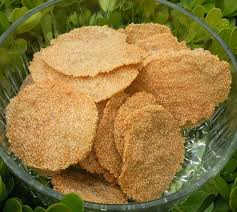Cook the amaranth and water in a medium pot over a high flame. Bring to a boil, reduce the heat, and simmer until the amaranth becomes sticky and forms a thick dough. Stir in the sunflower oil and allow to cool.
Preheat the oven to 300 degrees F. Line a baking sheet with parchment paper and lightly grease or use a silicone mat. Working with a teaspoon, put small mounds of the dough on the prepared baking sheet and lightly flatten with your hands until they are as thin as possible, about 1/8 inch. Bake until firm, about 1 hour. Allow to cool thoroughly before removing from mat.
Have you heard of amaranth? This sometimes-dubbed “superfood”, is a gluten-free, high-protein grain. It was first cultivated by the Aztecs over 8,000 years ago. Wild amaranth, a type of pigweed, is known as a pesky weed for some but valued by others.
Wild amaranth leaves and seeds can be foraged, but it’s best to know about the location you are harvesting it from. Amaranth can accumulate nitrates and oxalates, especially when it grows in soil that has been over-exposed to nitrates from commercial fertilizer. Amaranth can be found throughout fields, ditches, and pastures alike, but can also be cultivated in a backyard garden. There are many varieties of amaranth, many with the characteristics of being over six feet tall, with oval to diamond-shaped leaves, green stems that turn red as they mature, and tiny flowers that eventually dry out and yield tiny husked seeds that can be harvested.
Amaranth leaves can be cooked similar to spinach—steamed or sautéed in a little oil. Amaranth greens are similar to spinach and are a great source of vitamin C and vitamin A and a good source of calcium. You can find amaranth packaged in the store usually in the seed form or flour. It can usually be found in the baking aisle of your grocery store, or in the health food section.
The seed has a nutty flavor. It’s a much smaller, creamier grain than quinoa, and more comparable to polenta. The high-protein seeds can be cooked in boiling water for 25 to 30 minutes, one part seeds to two parts water.
This recipe was adapted from The Sioux Chef’s Indigenous Kitchen.
Ingredients
Directions
Cook the amaranth and water in a medium pot over a high flame. Bring to a boil, reduce the heat, and simmer until the amaranth becomes sticky and forms a thick dough. Stir in the sunflower oil and allow to cool.
Preheat the oven to 300 degrees F. Line a baking sheet with parchment paper and lightly grease or use a silicone mat. Working with a teaspoon, put small mounds of the dough on the prepared baking sheet and lightly flatten with your hands until they are as thin as possible, about 1/8 inch. Bake until firm, about 1 hour. Allow to cool thoroughly before removing from mat.


